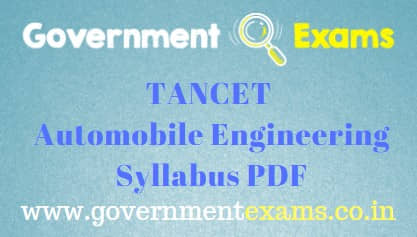TANCET Automobile Engineering Syllabus PDF:
Anna University, Chennai has officially announced the Common Engineering Entrance Test and Admission (CEETA-PG 2024)on behalf of the Government of Tamil Nadu. Candidates are interested in M.E./M.Tech./M.Arch./M.Plan. Degree Programmes offered at university departments, and constituent colleges of Anna University can check the official notification and apply till 07-02-2024. Here we uploaded the TANCET Automobile Engineering Syllabus and Model Question Paper with answers in PDF, Exam Pattern was uploaded and the same is given below. Candidates who took the CEETA-PG Entrance Exam can check the complete Automobile Engg syllabus and Exam Pattern along with the question paper below. Check the TANCET Automobile Engineering Syllabus PDF below:
Important dates of Anna University CEETA-PG 2024:
- Starting date for Online Registration: 10-01-2024
- Last date for Online Registration: 07-02-2024
- Downloading of Hall Ticket: 25-02-2024 (Tentative)
- Date of M.E./M.Tech./M.Arch./M.Plan Exam: 10-03-2024 10 AM to 12 PM (Sunday)
To see and check the complete CEETA-PG Exam 2024 notification and important details, check the link – TN CEETA PG 2024
For those looking for the TANCET Automobile Engg. Previous Year Question Papers PDF, Check the link – TANCET Automobile Engg. Question Papers PDF
TANCET Automobile Engg Syllabus & Exam Pattern:
TANCET Automobile Engineering M.E/M. Tech entrance exam consists of three Parts
- Part I: Engineering Mathematics – (Common to all candidates)
- Part II: Basic Engineering & Science – (Common to all candidates)
- Part III: Department Paper
Check the complete syllabus is updated below:
For the complete TANCET Syllabus 2024 PDF, Check the link – CEETA-PG Automobile Engg. Syllabus PDF
Automobile Engineering Syllabus – M.E/M.Tech:
PART – I Engineering Mathematics (Common to all Candidates)
– Determinants and Matrices
– Calculus and Differential Equations
– Vector Calculus
– Functions of Complex Variables and Complex Integration
– Transforms
– Numerical Methods
– Applied Probability
Part – II Basic Engineering & Science – (Common to all candidates)
– Applied Mechanics
– Mechanical Engineering
– Physics
– Material Science
– Civil Engineering
– Electrical Engineering
– Computers
– Chemistry
Part – III Automobile Engineering
Mechanics: Statics of Particles, Equilibrium of Rigid Bodies, Properties of surfaces and Solids, Dynamics of particles, Friction and Element of Rigid Body Dynamics – Basics of Mechanism, Kinematics of Linkage Mechanism, Kinematics of Cam Mechanism, Gears and Gear Trains, Friction, Force Analysis, Balancing and Vibration.
Strength of Materials and Design: Stress, Strain and Deformation of solids, Transverse Loading on Beams and Stresses in Beams, Deflection of Beams, Energy Principles, Thin Cylinders, and Spherical resells Torsion – Fundamentals of design for strength and Stiffness of Machine members, Design of Shaft and Couplings, Design of Fasteners and Welded Joints, Design of Spring and Engine parts, Design of Engine parts, Bearing and Flywheel, Design of Transmission system for flexible elements, Spur Gears and Parallel Axis Helical Gears, Bevel, Worm Gears and Crossed Helical Gears, Design of Gearboxes, Design of Cam, Clutches, and Brakes.
Thermodynamics: Basic concepts and First Law, Second Law, Entropy and Availability, Properties of Steam, Air standard cycles, Otto, Diesel and Dual cycles, Air compressors, Rankine cycle, Brayton cycle, Stream Turbines, Gas Turbine – Steam Nozzle, Refrigeration and air Conditioning, Conduction, Phase Change Heat Transfer and heat Exchangers, Radiation, Refrigeration Cycles, Refrigerants, System Components, VAR, Psychrometry, Air Conditioning system.
Production Technology: Foundry Technology, Hot and Cold Working, Forging, Principles and Application of Joining Process, Centre Lathe and Special purpose Lathes, Reciprocating Machines, Milling Machines and Gear Cutting, CNC Machine Tools, Part Programming.
Automotive Chassis: Front axle types front wheel geometry condition for true rolling motion steering geometry Ackermann and Davis steering. Types of steering gear box. Propeller shaft Universal joints. Final drive differential types. Type of brakes and constructional details. Types of suspension, Independent suspension-front and rear Rubber, pneumatic, hydro-elastic suspension.
Automotive Transmission: Construction and operation of friction clutches. Different types of gearboxes. Fluid couplings and torque converters. Wilson gearbox. Hydrostatic drive systems. Electric drive. Continuously Variable Transmission (CVT) types of car bodies classification of bus bodies.
Vehicle Body Engineering: Body optimization techniques for minimum drag. Wind tunnel technology. Classification of vibration, definitions. Single degree of freedom, free, forced and damped vibrations. Rolling resistance, cornering properties of tyres. Directional stability of vehicle Choice of suspension spring rate calculation of effective spring rate. Vehicle suspension in fore and aft. Vehicle ride model, Load distribution.
Automotive Electrical and Electronics: Types of Batteries, Principle, Construction, Starting System. D.C. Generators and Alternators. Regulations for charging Electronic ignition systems. Types of sensors and actuators for automobiles. Microprocessor-controlled devices in automobiles. Components for electronic engine management system. PID control types of solid-state ignition systems and their operation. Fuel control maps open loop control of fuel injection and closed-loop lambda control-integrated engine control system. Onboard diagnosis system.
Pollution and Control: Emission formation in SI and CI Engines. Effects of design and operating variables controlling techniques constant volume sampling systems. Measurement techniques of HC, CO, NOx and Smoke emission. Dilution Tunnel and Sound level meters.
Alternate Fuels: Properties alcohols, vegetable oils, biogas natural gas LPG and hydrogen as engine fuels methods of using all the fuels in SI and CI engines. Performance, emission and combustion behavior of the fuels in SI and CI engines.
For the complete TANCET Syllabus PDF 2023 Check the link – CEETA-PG Automobile Engg Syllabus PDF
For those looking for the TANCET Automobile Engg. Previous Year Question Papers PDF, Check the link – TANCET Automobile Engg. Question Papers PDF


